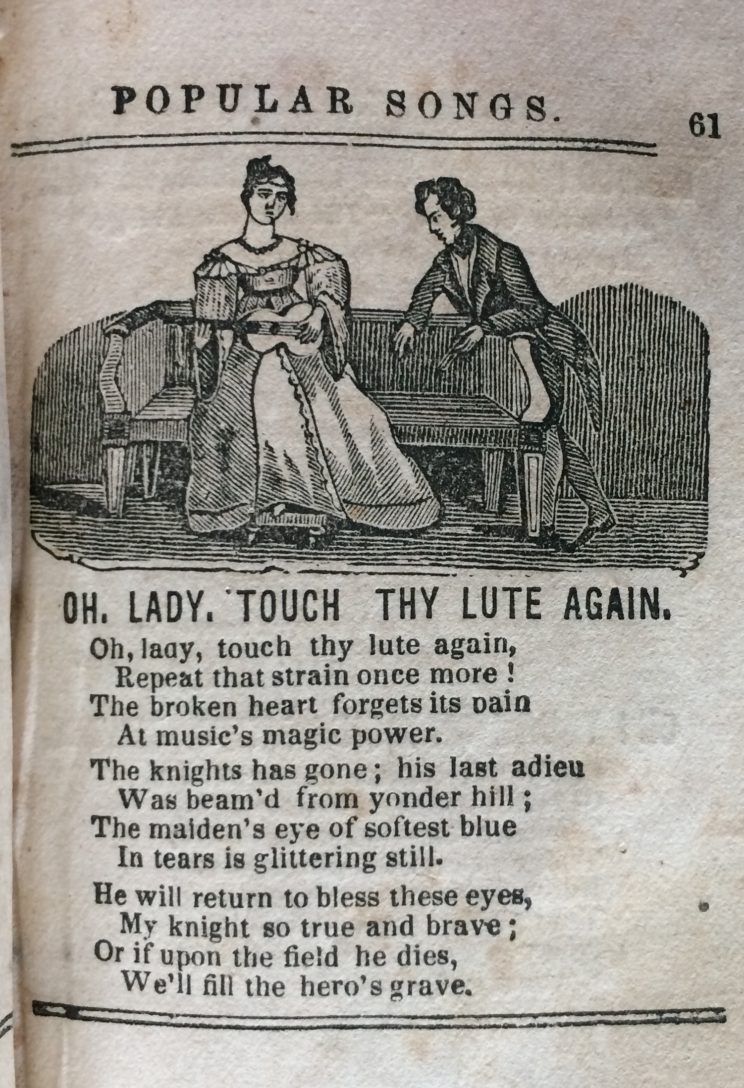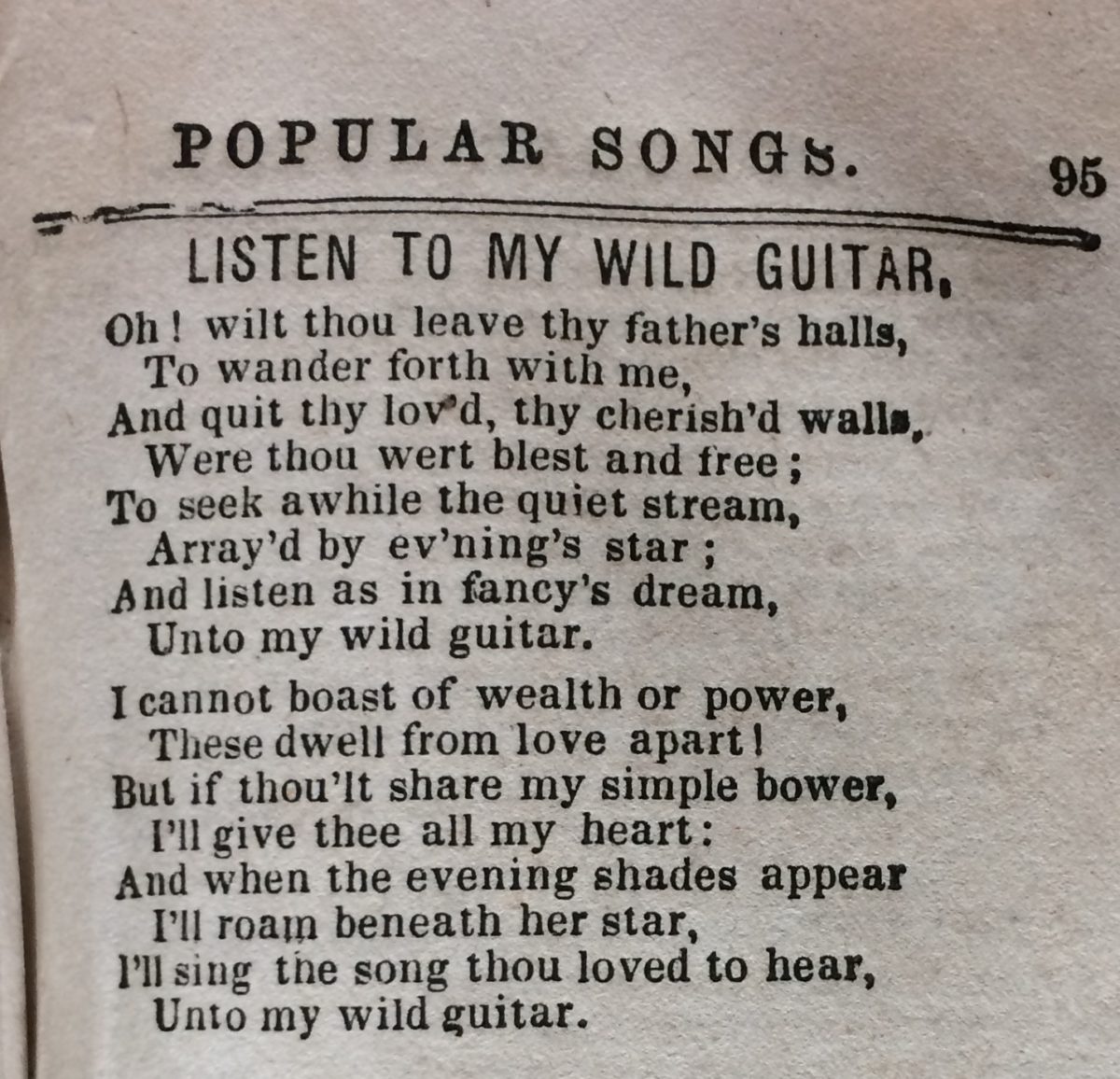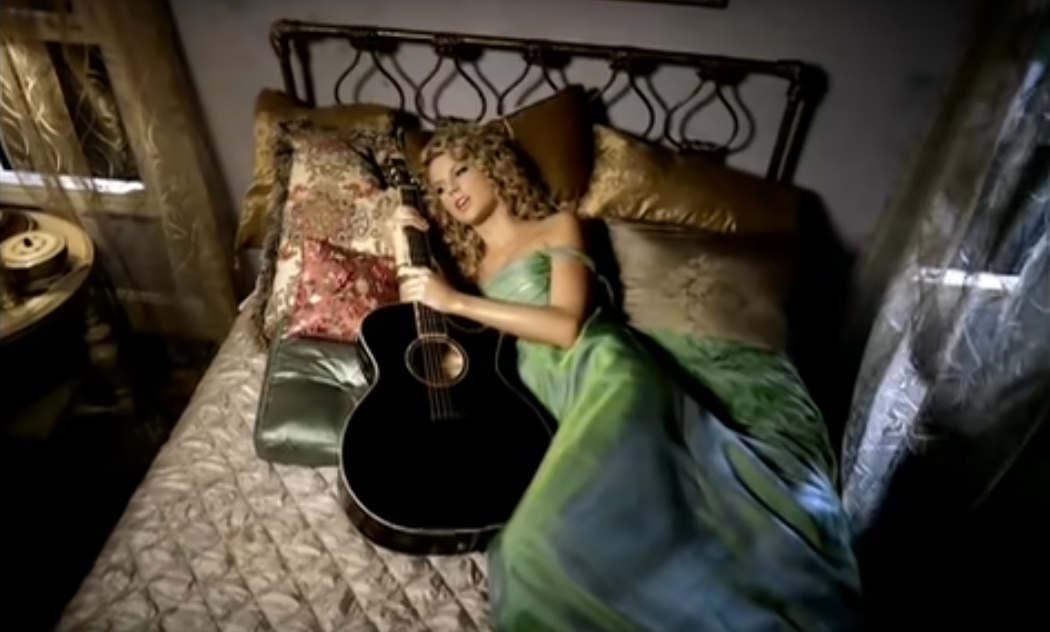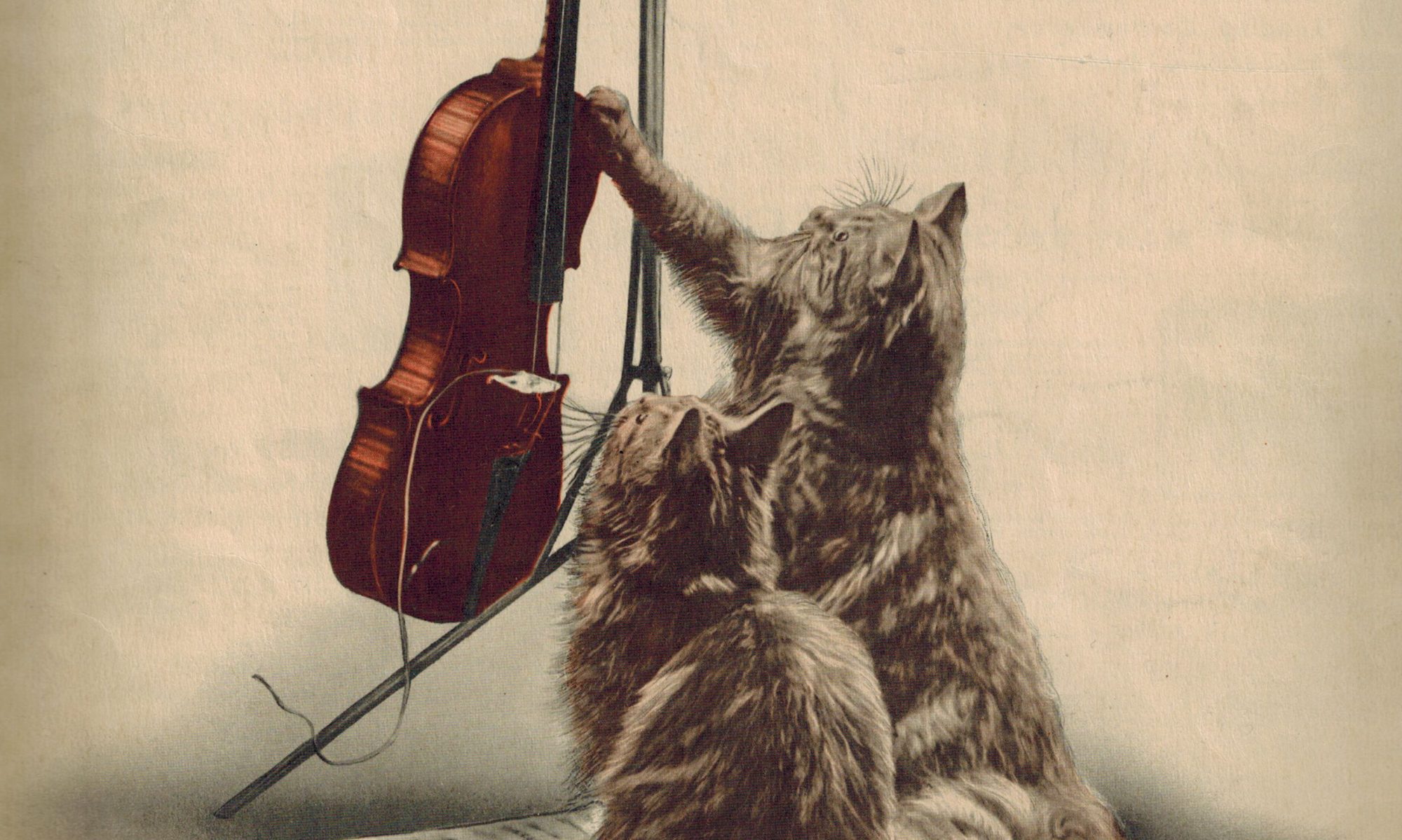in The Parlour Songster, Containing a Superior Collection of the Most Popular Sentimental Songs (1844)
In a 2015 Bustle article, Averi Clements compares a 1785 text by Francis Grose to today’s Urbandictionary.com. Quoting from the Classical Dictionary of the Vulgar Tongue, Clements presents a list of 20 eighteenth-century suggestive slang words for sexual behaviour. The list includes two musical metonyms: “to bagpipe” referred to fellatio—or more colloquially, the act of performing a blowjob—and “to strum” meant to have sex with a woman [i]. The second of these vernacular verbs is of particular relevance to my interest here: the early history of guitar sex pop music euphemism. For this, we turn our attention to the oldest—and most expensive—item in the Sentimental Museum.

Published in 1844, The Parlour Songster, Containing A Superior Collection of the Most Popular Sentimental Songs, Many of Which Are Now First Printed features the lyrics to nearly three hundred songs across its 240 palm-sized pages. The hard-cover volume contains a descriptive title page with an etched frontispiece entitled “The Miser” that was engraved by Edwin M. Ellis (1809-1882). Ellis was an engraver known for his portraits and landscapes. He lived in Philadelphia where he achieved notoriety as the engraver for Godey’s Lady’s Book, a women’s magazine founded by Louis Antoine Godey and published from 1830 to 1878. Two additional, but unsigned, wood engravings are included within the volume’s pages.
In addition to the lengthy title, publication details also mark the opening page. Turner & Fisher published The Parlour Songster and the title page lists both of the firm’s two offices at 74 Chatham Street in New York and at No. 15 N. Sixth Street in Philadelphia. Renamed Park Row in 1886, Chatham Street was a center of entertainment in mid-nineteenth century Manhattan. It boasted hotels, saloons, theatres, and eventually vaudeville, as well as Printing House Square, a primary publisher of cheap ephemera—musical and otherwise. This locale was marked with poverty and prostitution; nineteenth-century writers expressed race- and class-based anxieties about the relationship between what was referred to as street literature produced here and its audience or market.

Following the title page and Ellis’s engraving, the volume then jumps to the real business at hand: popular sentimental songs. The Parlour Songster—like other songsters—does not feature notated music, but instead only song lyrics, most of which are unattributed. “The Minstrel Boy” is a rarity in that it names the tune to which its lyrics should be sung—”The Moreen”—but the vast majority of songs in The Parlour Songster do not reference these kinds of sonic traces. The extended subtitle claims to proffer many new songs, but a significant number were already popular at the time of publication. These include: “Robin Adair”; “Coming Thro’ the Rye”; “Ellen Aureen”; “Hail Columbia”; and “Oft in the Stilly Night” to name a few. Like other sentimental songs of this era, many of the songs are performed in the first person from the perspective of a male protagonist. “I Love My Jean” and “Oh! Mary, When the Wild Winds Blow” are just two examples. It was not uncommon for volumes in this style and of this era to feature a lengthy preface about the songs within or to attribute the collection to its compiler or compilers, but The Parlour Songster offers neither. The final pages of the volume offer a useful index of songs, alphabetized by the first word of each song’s title.
While most of the songs included herein do not identify a songwriter or author, several employ the practice of listing the performer associated with the song as in the case of “The Rose of Cashmere” which, as noted, was “Sung by Mr. Wilson.” At least a dozen songs in The Parlour Songster are marked with the notation “As Sung by Mr. Dempster.” These include sentimental numbers such as “Oh! Promise Me to Sing, Love.” The text for “Auld Robin Gray” notes that the song was not only sung by Mr. Dempster but also received “at the concerts, with unbounded applause.” William Richardson Dempster (1809-1871) was a Scottish singer and composer who traveled often to the US to perform. Nicholas Tawa describes Dempster’s popularity as a singer:
Although of inadequate strength to fill a large hall, his voice was admired for its sweetness and its effective projection of the sentiments in parlor ballads, especially those of his own composition. Dempster spent several years in America, then traveled back and forth to Great Britain, giving concerts on both sides of the Atlantic. He was always, however, more popular in America than in his own country; large numbers of Americans came to hear him and many declared him to be the finest English ballad singer then appearing in the United States [ii].
Of the songs attributed to songwriters, Thomas Moore (1779-1852) gets the most play. The popular Irish poet, singer, and songwriter penned five of the Parlour Songster texts: “Then Look Not Thou So Bright and Blessed”; “Unbind Thee, Love”; “Then First From Love”; “Sovereign Woman”; and “The Thorn.” Henry Russell, a singer known for his tearful and tear-jerking performances of sentimental songs, also has a song in The Parlour Songster. Russell’s “The Orphan Ballad Singers” relies on one of the most familiar stock characters of sentimental literature and song: the parentless child.
And now to the most titillating titles of the collection. “Oh, Lady, Touch Thy Lute Again” and “Listen to My Wild Guitar” are the most intriguing songs in The Parlour Songster, offering an early pop history of guitar sex double entendre. The collision of these instruments with suggestiveness is no accident; recall that “to strum” refers to a stringed instrument. Both songs feature typical sentimental song references to hearts, tears, and even death—paging Monteverdi!—but they also recode sentimental references to music’s power to move and to stir by positioning the guitar as a sexy, but safe intermediary.

“Oh, Lady, Touch Thy Lute Again” is included in several other songsters from the early nineteenth century and the University of St. Andrews Library claims to hold a piano-vocal score (!) An 1824 issue of The Monthly Magazine; Or, British Register features a performance review of the song that reveals several additional details: the song was written by W. Bygrave, Esq. and composed and sung by S. Nelson “at the Nobility’s Concerts”:
Of this ballad we cannot speak in terms of high commendation. The air is neither remarkable for its novelty nor its beauty. The only merit it possesses is that of being consistent with Mr. Bygrave’s words, which, both poetically and mechanically, are as poor as any that we have read for a long time (Vol. 58, Sept. 1, 1824, 164).
“Listen to My Wild Guitar” features in at least one other songster and The British Library lists a 5-page score, published by Mayhew & Co. in 1827 in its holdings. An 1829 volume of The Athenaeum and Literary Chronicle notes that “Listen to My Wild Guitar” was written as a companion to the celebrated Serenade, ‘The Light Guitar,’ composed by John Barnett.

To be clear, the question of sexual autonomy is not a topic I take lightly nor one that I understand as transhistorical. But long before Jimi Hendrix did the “Wild Thing” with his guitar at the Monterey Pop Festival, or Taylor Swift bedded hers in the video for “Teardrops on My Guitar”—also sentimental!—nineteenth-century songwriters composed euphemistically sexual songs about stringed instruments. We will never know what these two jams sounded like when singers gathered around The Parlour Songster, or if people chose to sing these two songs at all; however, it doesn’t require a leap of the sonic imagination to hear their continued resonances in more contemporary pop song.

[1] Clements, Averi. “How to Talk Dirty Using 18th Century Sex Slang, Because It’s Time to Take Your Sexting on a Time Machine Ride.” Bustle. May 19, 2015. Accessed July 10, 2019.https://www.bustle.com/articles/82866-how-to-talk-dirty-using-18th-century-sex-slang-because-its-time-to-take-your-sexting
[2] Tawa, Nicholas E. Dempster, William Richardson. Grove Music Online. July 1, 2014. Accessed July 9, 2019, from https://www.oxfordmusiconline.com/grovemusic/view/10.1093/gmo/9781561592630.001.0001/omo-9781561592630-e-1002262206
For more about the history of sex, guitars, and popular music, see:
Powers, Ann. Good Booty: Love and Sex, Black & White, Body and Soul in American Music. New York: HarperCollins Publishers, 2017.
Waksman, Steve. Instruments of Desire: The Electric Guitar and the Shaping of Musical Experience. Cambridge, MA: Harvard University Press, 1999.
Here’s how to cite this blog post:
Gale, Emily. “The Early History of Guitar Sex Euphemism.” Sentimental Museum of Musical Ephemera. July 11, 2019. Accessed month, date, year, from http://sentimentalmuseum.com/the-early-history-of-guitar-sex-euphemism/
